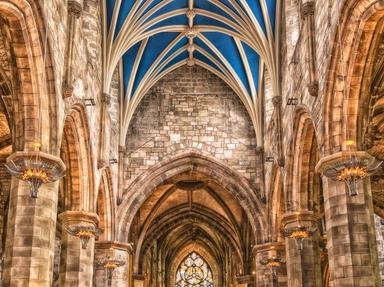Quiz Answer Key and Fun Facts
1. High on a mountain range in the Himalayas in the northern state of Uttarakhand lies a temple site to which followers of Shiva make holy pilgrimage. Due to extreme cold weather, the pilgrimage can only be made during the summer months. The difficult nine-mile climb up to the temple begins in the city of Gaurikund. What is the name of this temple?
2. In southern Peru, a collection of lines have been carved into the desert. Historians agree that these lines are religious in origin but no one really knows their purpose. These ancient line carvings are known by what name?
3. A tiny volcanic island located 2,200 miles off the coast of Chile is home to hundreds of stone statues known as Moai. Carved from volcanic ash sometime between 300 and 1200 CE, can you name this famous island?
4. There is a complex of temples located in north-western Cambodia that draws visitors from all over the world. One of the largest and most-admired religious monuments can be found within the complex. What is this monument called?
5. European settlers named this huge sandstone mound Ayers Rock. It rises 1,115 feet out of the flatland in the Northern Territory of Australia. Much of Ayers Rock lies below the surface of the ground. By what name is Ayers Rock also known?
6. An enormous statue rises above the Min River in the Szechuan province of China. This statue faces Mount Emei, a mountain sacred to Buddhists. A Buddhist monk by the name of Hai Tong began carving the statue in 713 CE, during the Tang dynasty. This statue is known as what?
7. This pre-Mayan city, west of Oaxaca City in southern Mexico, overlooks a green plain that seems to stretch forever. The Zapotec people founded this city in 500 BCE. Can you name this ancient place?
8. There is a small chapel located in Sedlec, a suburb of Kutna Hora, Czech Republic, that sits beneath the cemetery of the Church of All Saints. This chapel is decorated with bones...lots of them. What is this chapel called?
9. A 12th-century church, located in Bruges, Belgium, houses one of the world's most sacred Christian relics: a vial of Holy Blood. What is this world-famous basilica called?
10. Located on a ridge of Medicine Mountain in Wyoming's Bighorn National Forest is a very large wheel. It is believed that the wheel was created from rocks gathered from the surface of the mountain about 700 years ago. No one really knows who built the wheel, but a local Crow tribe has its own beliefs. What IS known about the wheel is that it's aligned with the moon, sun, and stars. What is the name of this wheel on the mountain?
Source: Author
nmerr
This quiz was reviewed by FunTrivia editor
stedman before going online.
Any errors found in FunTrivia content are routinely corrected through our feedback system.

